Earth Flees Giant Planets at the Equinox, Ganymede Goes Missing, and the Awesome Andromeda Galaxy!
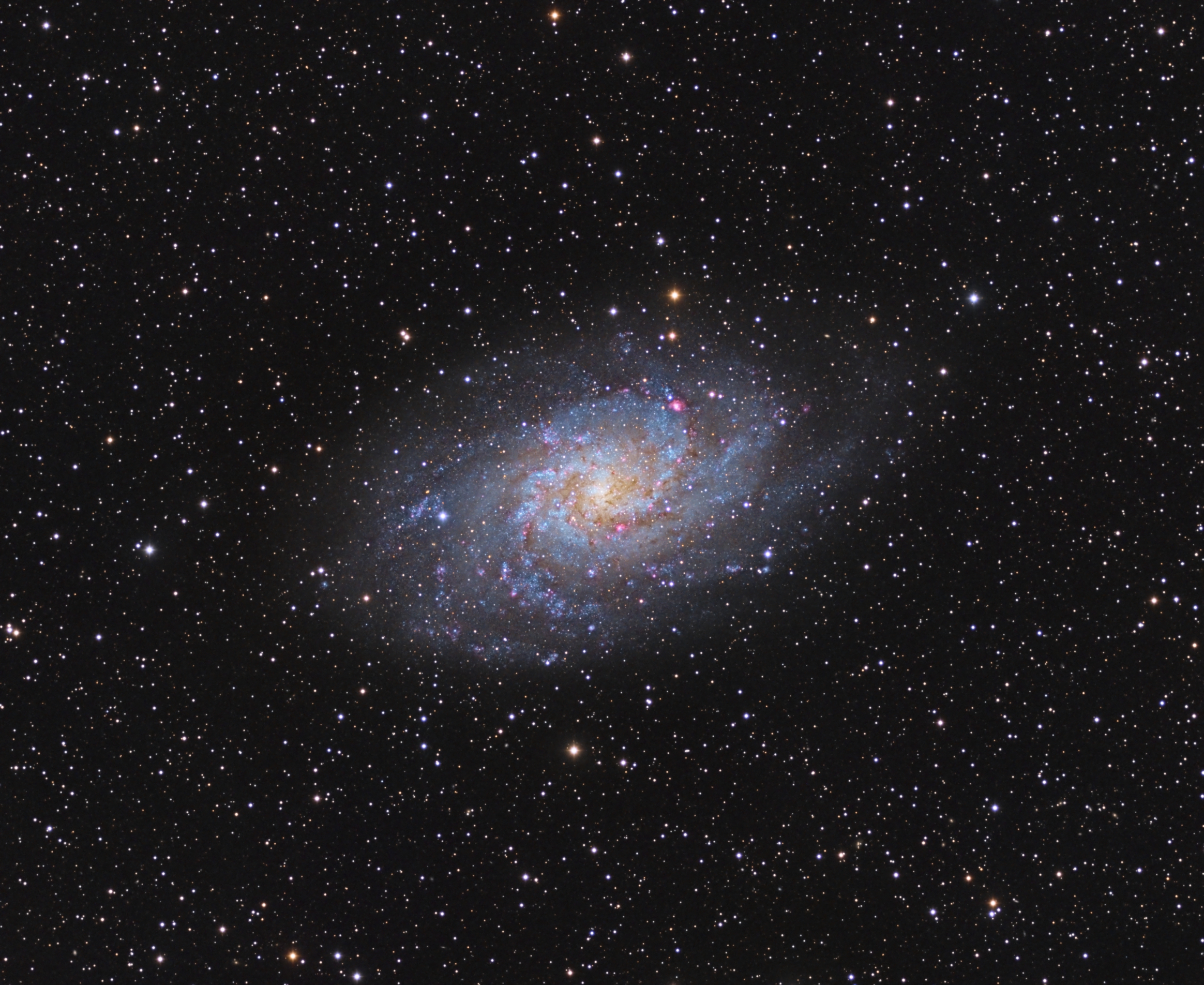
The beautiful Triangulum Galaxy, also known as Messier 33, dim because it is oriented nearly face-on to Earth, spans 1.5 full moon diameters in the sky. Some people have been able to see it with unaided eyes. At 2.75 million light-years from Earth – that’s the farthest object a human eye can see! This image was taken by master astrophotographer Ron Brecher of Guelph, Ontario. His gallery of spectacular astro-images can be viewed at his website, www.astrodoc.ca.
Hello, End of Summer Stargazers!
Here are your Astronomy Skylights for the week of September 22nd, 2019 by Chris Vaughan. Feel free to pass this along to your friends and send me your comments, questions, and suggested topics. I repost these emails with photos at http://astrogeo.ca/skylights/ where all the old editions will be archived. You can also follow me on Twitter as @astrogeoguy! Unless otherwise noted, all times are Eastern Time. Please click this MailChimp link to subscribe to these emails.
I can bring my Digital Starlab portable inflatable planetarium to your school or other daytime or evening event. Contact me through AstroGeo.ca, and we’ll tour the Universe together!
For those who like to read my Skylights on Tumblr, I am now migrating the content to my website, where I can better control the size of the photos and sky charts. The page where the Skylights are listed is located at http://astrogeo.ca/skylights/. We’re still ironing out the site, so let me know if you have any comments or suggestions.
Happy Northern Autumnal Equinox!
At 3:50 pm Eastern Daylight Time on Monday, September 23, the Equinox occurs, and autumn officially begins in the Northern Hemisphere. Here’s why…
At any given time, from our point of view here on Earth, the sun is situated in front of the distant background stars (although we can’t see them due to its bright glare). As Earth completes one orbit of the sun every year, the sun appears to shift eastward through those fixed stars, tracing a great circle around the sky. That circle is called the Ecliptic. Because Earth’s orbit is in more or less the same plane as all the other planets, the major Solar System bodies are always positioned near that imaginary track around the sky.
Now, imagine a second circle positioned directly over the Earth’s equator, and painted as a strip around the sky, and dividing the celestial sphere into two great bowls, the Northern Hemisphere stars and the Southern stars. Since the Earth’s equator is south of observers located in the Northern Hemisphere, that Celestial Equator circle around the sky is always in the southern part of the sky, and runs from the eastern horizon to the western horizon.
Because the Earth’s axis of rotation is tilted 23.5° away from the Ecliptic, the equator circle and the ecliptic circle behave like two hula hoops with the same centre, but with one tilted so that they intersect at only two spots. At the moment of the Autumnal Equinox, the sun is situated at one of the intersection points – and its apparent motion through the stars is carrying it into the southern bowl of the sky – as if it is “stepping over” the equator. Six months from now, on the Vernal Equinox, the sun will again cross the Celestial Equator at the other intersection point – this time heading into the northern bowl of the sky. At that moment, Spring will begin for the Northern Hemisphere.
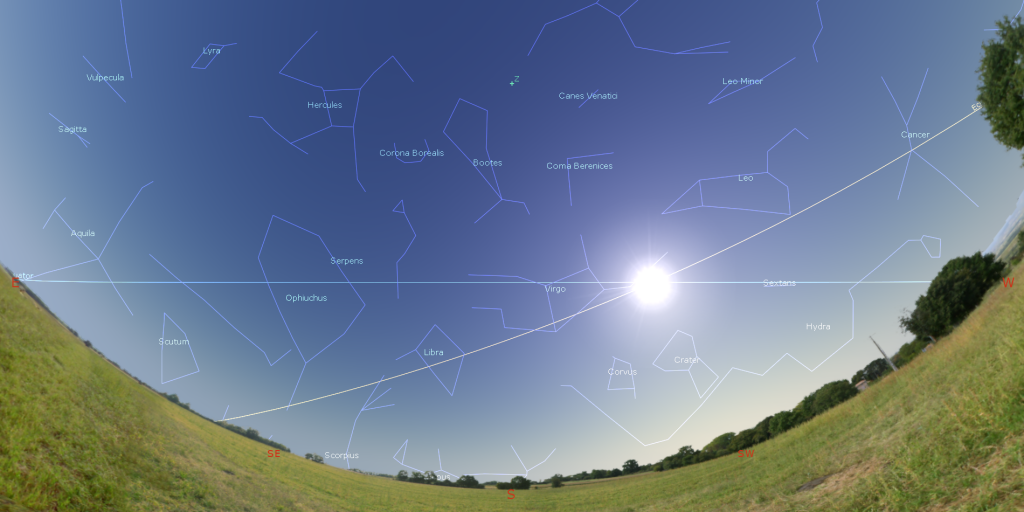
The Equinox triggers a few interesting effects. At the equinoxes, the sun rises due east and sets due west. For the six months following the September equinox, the sun will spend all of each day in front of the southern hemisphere stars, and also high overhead of the lucky folks who live there! With the sun higher in their sky, they experience more daylight hours and receive more highly concentrated solar radiation, producing warmer weather. (Compare the intensity of a flashlight’s light when it’s beamed straight at a wall versus obliquely at the wall. The bright circle of the beam gets weaker when it spreads into an oval.) At the same time, North Americans, Europeans, and Asians have to accept shorter, colder days and longer nights (which are great for warmly dressed astronomers). On the day of the Equinox, everyone worldwide experiences 12 hours each of daytime and night-time. This is where the term, Latin for “equal night”, comes from.
The nights around the equinoxes offer better chances to see the aurorae at high northern and southern latitudes, too. Just as two bar magnets lined up with their poles in the same direction repel one another strongly, the Earth’s magnetic field repels the sun’s field. At the equinoxes, the Earth’s axis tilts neither towards nor away from the Sun, so the two “magnets” aren’t lined up as well, reducing Earth’s ability to deflect the Sun’s field and the charged particles that trigger aurorae in our upper atmosphere.
At this point in September every year, the Earth is travelling almost directly towards the stars that mark the upraised club of Orion (the Hunter) and the toes of Gemini (the Twins). That produces the “bugs on a windshield” effect when the Orionids meteor shower particles strike the Earth’s upper atmosphere and produce the streaks of light we see. At the same time, Earth is travelling almost directly away from the stars of Sagittarius (the Archer) and Ophiuchus (the Water-Bearer). Since Jupiter and Saturn occupy those constellations this year, Earth is rapidly increasing our distance from those two bright planets this week.
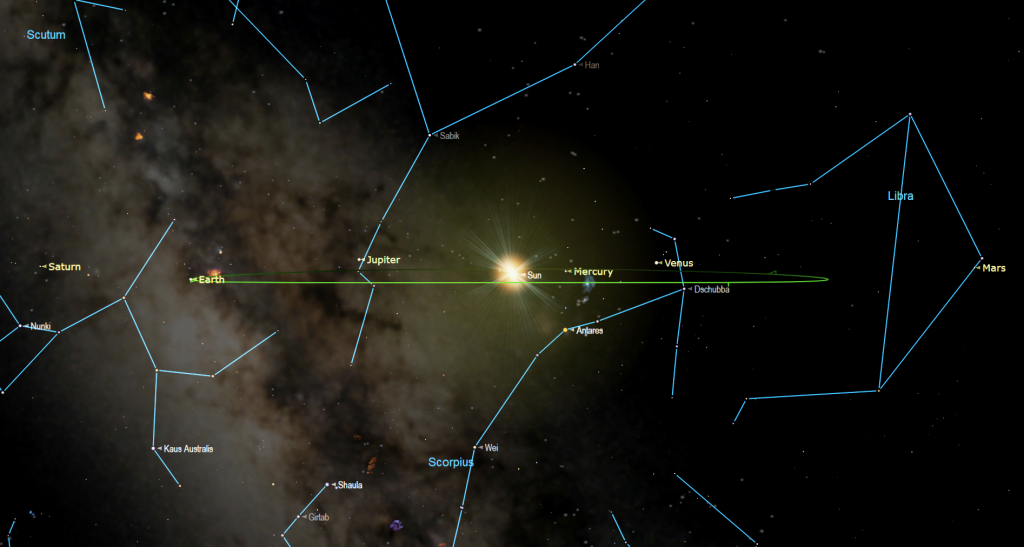
A final aside: The sun’s path along the Ecliptic is where the Zodiac originated. Early sky watchers noted that, in the course of one year, the sun travelled through twelve (well, 13 actually) constellations, passing through the same constellation every year on the same range of dates. Over the centuries, the dates have shifted somewhat. Nowadays, every year in the third week of September, the sun sits among the stars of the constellation Virgo (the Maiden).
The Moon and Planets
It’s that time of the moon again! The aging moon has completely vacated the evening sky as it slides towards the pre-dawn sun, leaving nights extra dark all over the world. (Well – except at the poles, anyway.) Combining that with earlier sunsets (in the Northern Hemisphere) and still-mild temperatures, and you get perfect conditions for stargazing! Here are your Skylights!
This week will begin with the crescent moon rising well after midnight local time, and sitting among the waist stars of the twin figures of Gemini. In the eastern pre-dawn sky on Tuesday morning, the moon will be positioned about a palm’s width above (or to the celestial west of) the large, bright, open star cluster known as the Beehive, Praesepe, and Messier 44. On Wednesday morning, the moon’s orbital motion will place it about the same distance below (to the east of) the Beehive. Observers in Asia will get to see the moon pass through the cluster.
On Thursday morning, the slim crescent moon will pass a couple of finger widths to the left (celestial north) of the bright, white star Regulus in Leo (the Lion). Just before sunrise on both Friday and Saturday morning, look for the silver slivered moon sitting low above the eastern horizon. Sharp eyes might glimpse the planet Mars sitting a fist’s width below the moon on Friday, and a palm’s width to the upper right of the moon on Saturday.
The new moon phase will officially occur at 2:26 pm EDT on Saturday afternoon. At its new phase, the moon is travelling between Earth and the sun. Since sunlight can only reach the far side of the moon, and the moon is in the same region of the sky as the sun, the moon becomes completely hidden from view. Because the moon’s closest approach to Earth (perigee) this month will occur only 16.5 hours before this new moon, the combined gravitational tugs of the sun and moon pulling from the same direction in space will generate large tides on Earth for several days.
But wait – there’s more! The moon’s orbit is tilted by 5° with respect to Earth’s, so it can wander that far above and below the sun. At this new moon, the moon will be almost as far north of the sun as it can get. So the moon will remain visible, sitting very low over the western horizon, after sunset. At the same time, the bright planet Venus might be glimpsed about a fist’s width to the left of the moon. And dimmer Mercury will be another palm’s width beyond Venus. I’ll post a diagram here. The following evening (Sunday), the moon will climb to sit a palm’s width above, and between, Mercury and Venus.

Here’s what the planets are up to this week. Mars is now pulling away from the sun’s glare and will become increasingly more visible in the eastern pre-dawn sky in the coming weeks. It will rise at about 6:30 pm local time this week. Unfortunately, the red planet is on the far side of the sun from us and it will remain small and faint until 2020 begins.
Meanwhile, Mercury and Venus are in the process of swinging away from the sun, but the shallow ecliptic will prevent them from climbing above the glare of sunset for a while longer. This week, you might be able to see Mercury and Venus sitting very low in the west for about 20 minutes after the sun disappears. Tonight (Sunday), Mercury will be positioned about four finger widths to the left (celestial east) of Venus. It will increase that separation all this week. Observers near the equator and in the Southern Hemisphere will see those two inner planets well in the next couple of weeks.
The earlier-arriving sunsets of September will allow us to view spectacularly bright Jupiter for a while yet, even though the planet is steadily shifting towards the sun. As the sky begins to darken this week, look for the giant planet sitting less than a third of the way up the southwestern sky. Hour by hour, Jupiter will sink lower – then set in the west by about 10:45 pm local time. Jupiter has spent this year below the stars of Ophiuchus (the Serpent-Bearer) and above Scorpius (the Scorpion).
On a typical night, even a backyard telescope will show you Jupiter’s two main equatorial stripes and its four Galilean moons – Io, Europa, Callisto, and Ganymede looking like small white dots arranged in a rough line flanking the planet. Good binoculars will show the moons, too! If you see fewer than four dots, then the others are in front of Jupiter, or hidden behind it. Or, it might be that some moons are not being illuminated by sunlight because they are in eclipse!
If you watch Jupiter on Monday evening, September 23 before 9:15 pm EDT, you will see four moons – Callisto, Io, and Ganymede on the east side and Europa on the west side. But at about 9:20 pm Eastern Daylight Time, the moon Ganymede (the one closest to Jupiter) will suddenly disappear when it enters Jupiter’s shadow and is no longer bathed in sunlight! If your telescope has motors to track Jupiter, attach a smartphone holder and record a video of the moon disappearing. In the reverse of this process, on Friday night at 8:45 pm EDT, Europa will suddenly pop into view near Jupiter.
Due to Jupiter’s rapid 10-hour rotation period, the Great Red Spot (or GRS) is only observable from Earth every 2nd or 3rd night, and only during a predictable three-hour window. The GRS will be easiest to see using a medium-sized, or larger, aperture telescope on an evening of good seeing (steady air). If you’d like to see the Great Red Spot in your telescope, it will be crossing the planet on Tuesday evening from dusk to 10 pm EDT, and on Thursday from 8 to 10 pm EDT.
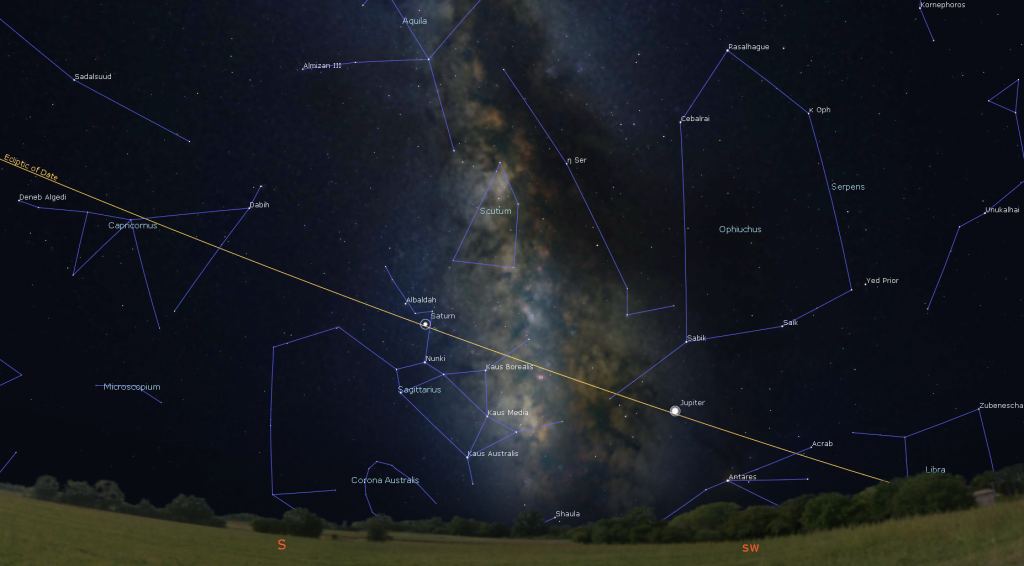
Yellow-tinted Saturn is prominent in the southern evening sky, too – but it is much less bright than Jupiter. The ringed planet will be visible from dusk until about 12:30 am local time. Saturn’s position in the sky is just to the upper left (or celestial east) of the stars that form the teapot-shaped constellation of Sagittarius (the Archer). To find Saturn, look about 3 fist diameters to the left (celestial east) of Jupiter. The Milky Way is between them.
Saturn is well worth dusting off your old telescope! Once the sky is dark, even a small telescope will show Saturn’s rings and several of its brighter moons, especially Titan! Because Saturn’s axis of rotation is tipped about 27° from vertical (a bit more than Earth’s axis), we can see the top surface of its rings, and its moons can arrange themselves above, below, or to either side of the planet. During this week, Titan will migrate counter-clockwise around Saturn, moving from the lower left of Saturn tonight (Sunday) to the right of the planet next Sunday. (Remember that your telescope will flip the view around.)
Distant, blue Neptune is still more or less at its closest to Earth for the year. The dim, magnitude 7.8, blue planet is visible all night long among the stars of eastern Aquarius, just a small distance to the right (celestial west) of a medium-bright star named Phi (φ) Aquarii. Both blue Neptune and that golden-tinted star will appear together in the field of view of a backyard telescope at medium power. The distance between the star and the planet will steadily increase due to Neptune’s westward retrograde orbital motion. I posted a diagram of Neptune’s position compared to that star here.
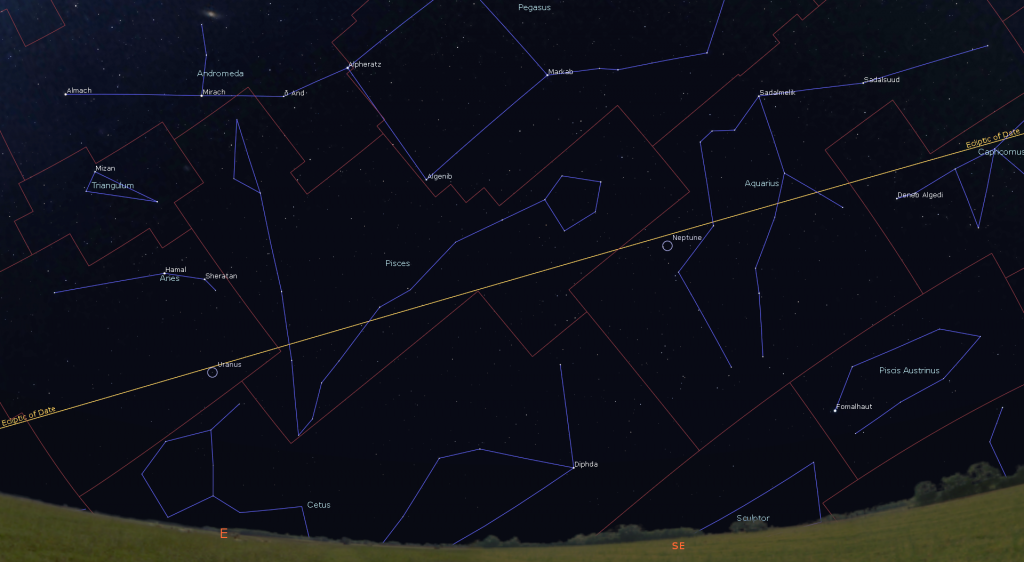
Blue-green Uranus will be rising in the east at about 8:30 pm local time this week; and it will remain visible all night long. Uranus is sitting below (or to the celestial south of) the stars of Aries (the Ram) and is just a palm’s width above the head of Cetus (the Whale). At magnitude 5.8, Uranus is actually bright enough to see in binoculars and small telescopes, under dark skies. You can use the three modest stars that form the top of the head of the whale (or sea-monster in some tales) to locate Uranus this autumn – that’s because the distant planet moves so slowly in its orbit. To help you find it, I posted a detailed star chart here.
Zodiacal Light
During moonless periods in September and October, the steep morning ecliptic favors the appearance of the zodiacal light in the eastern sky for about half an hour before dawn. The glow is sunlight reflected from interplanetary particles drifting in the plane of our solar system. During this week, look east, below the stars of Leo (the Lion), for a broad wedge of faint light rising from the horizon and centered on the ecliptic. (The ecliptic passes directly through the bright star Regulus in Leo.) Don’t confuse the zodiacal light with distant light pollution, or the Milky Way, which is sitting further to the southeast.
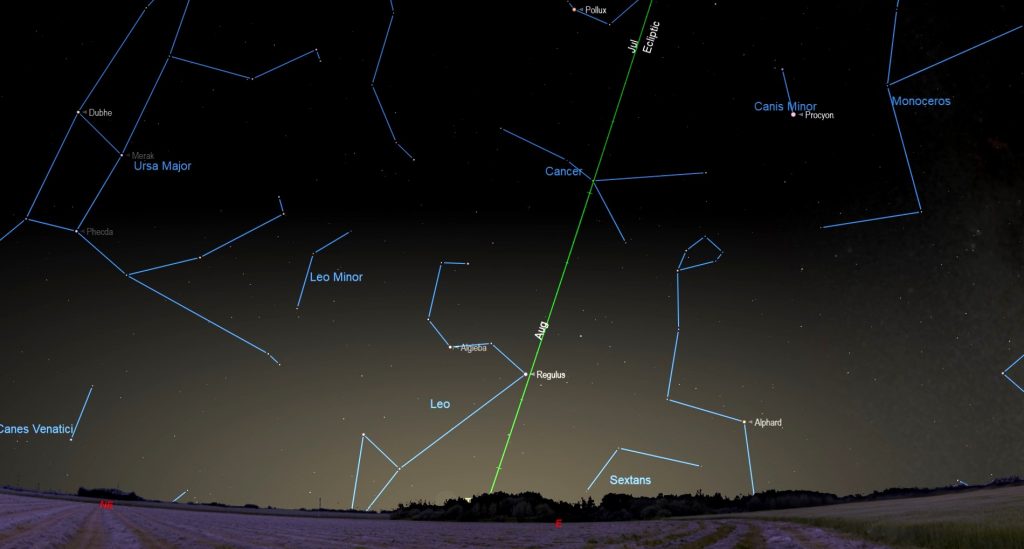
Seeing Giant Galaxies
We’ve begun the season to look for the farthest object a human eyeball can see without help* – the Andromeda Galaxy, or Messier 31. This large spiral galaxy is a sister to our own Milky Way galaxy. It sits 2.5 million light-years away from our sun, meaning that its stars’ light has been journeying for that length of time. And, if there are alien astronomers there looking at us, they are seeing our solar system as we were 2.5 million years ago!
Under dark skies, using unaided eyes only, you should be able to see a faint fuzzy patch that is elongated left to right. The galaxy spans six full moon diameters across the sky, but only its bright core and the surrounding, inner halo are usually seen visually. The galaxy is quite easy to see with binoculars.

Because their fields of view are too narrow to see the entire galaxy, small telescopes generally only show its bright core. While looking, see if you can see M31’s two small, fuzzy-looking companions, the small elliptical galaxies designated M32 and M110. M32 is closer to the main galaxy’s core and it situated just to the lower right (or to the celestial south). M110 is above (or northeast of) the main core and is slightly farther away. At 2.49 million light-years, M32 is closer to us than the Andromeda Galaxy; while M110 is 200,000 light-years farther away.
In late September, the Andromeda Galaxy is about halfway up the east-northeastern sky at 10 pm local time (That is, lower than that before 10 pm, and higher later than 10 pm). To locate it, you can first find the medium-bright star Mirach. It’s the second star east of the eastern corner of the Great Square of Pegasus. Then look for a dimmer star about 4 finger widths above Mirach. The galaxy is higher by that same distance. Alternatively, you can use the highest three stars of the W-shaped constellation Cassiopeia (the Queen). Those three bright stars form an arrow that points directly at M31.
*Another large galaxy, called Messier 33 in Triangulum (the Triangle), is 2.75 million light-years away. Observers with very keen eyes under very dark sky conditions can sometimes see it, too – setting the record. This galaxy is tougher because it is oriented nearly face-on to Earth – so its light is spread across a large patch of sky (equal to 1.5 full moon diameters), making it dimmer overall. It sits only 1.3 fist diameters below M31, a palm’s width below the star Mirach.
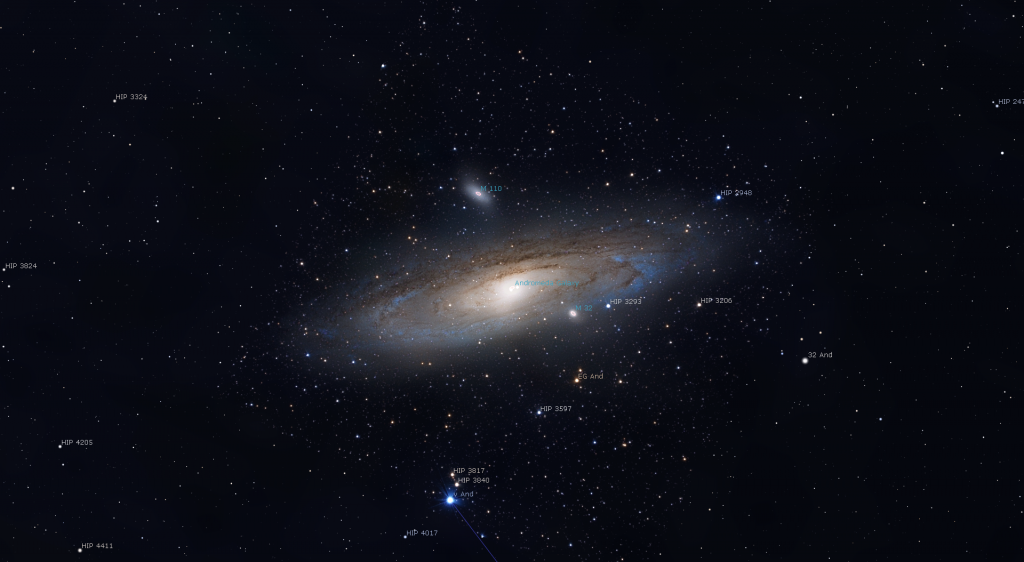
Public Astro-Themed Events
Taking advantage of dark, moonless evening skies this week, astronomers with the RASC Toronto Centre will gather for dark sky stargazing at Long Sault Conservation Area, northeast of Oshawa on (only) the first clear evening (Monday, Tuesday, or Thursday) this week. You don’t need to be a RASC member, or own any equipment, to join them. Check here for details and watch the banner on their homepage or their Facebook page for the GO or NO-GO decision around 5 pm each day.
Every Monday evening, York University’s Allan I. Carswell Observatory runs an online star party – broadcasting views from four telescopes/cameras, answering viewer questions, and taking requests! Details are here. On Wednesday nights they offer free public viewing through their rooftop telescopes. If it’s cloudy, the astronomers give tours and presentations. Details are here.
At 7:30 pm on Wednesday, September 25, the RASC Toronto Centre will hold their free monthly Speaker’s Night Meeting at the Ontario Science Centre, and the public are welcome. This month, the speaker will be Major (retired) Ted King. His topic will be Heavenly Help to the Rescue, the satellite-based international search and rescue system. Check here for details. Parking is free.
On Wednesday, September 25 from 8 to 10 pm, on the top of the McLennan Physics building downtown at U of T, the Astronomy and Space Exploration Society will host a free, drop-in star party – with “ask the astronomer” and free hot chocolate! Details are here.
On Thursday, September 26 at 6:30 pm at Toronto Reference Library, U of Toronto’s Jennifer West will present a free public talk entitled Nature’s Supercolliders: The Extreme Environments of Stellar Graveyards. Details are here.
On Thursday, September 26, starting at 7 pm, U of T’s AstroTour Keynote will present Dr. Gurtina Besla, Assistant Professor in the Department of Astronomy and Steward Observatory at the University of Arizona, speaking on The Milky Way in Motion. This free public event will also include planetarium shows. Details are here.
In celebration of the Ontario Science Centre’s 50th Birthday, they are hosting a Community Weekend on September 28-29 that includes space and astronomy-themed exhibitions. During this week they are also offering safe solar observing by RASC astronomers (weather permitting). Details are here.
On Sunday afternoon, September 29, at the JRR Macleod Auditorium at U of T, The Royal Canadian Institute and the Canadian Museum of Nature will present a free public event entitled Botanizing “Mars”: Learning about Earth while preparing for the Red Planet. Space is limited, registration is here.
The next RASC-hosted Night at the David Dunlap Observatory will be on Saturday, October 19. There will be sky tours in the Skylab planetarium room, space crafts, a tour of the giant 74” telescope, and viewing through the 74” and lawn telescopes (weather permitting). The doors will open at 7 pm for a 7:30 pm start. Attendance is by tickets only, available here. If you are a RASC Toronto Centre member and wish to help us at DDO in the future, please fill out the volunteer form here. And to join RASC Toronto Centre, visit this page.
This Fall and Winter, spend a Sunday afternoon in the other dome at the David Dunlap Observatory! On Sunday afternoon, October 20, from noon to 4 pm, join me in my Starlab Digital Planetarium for an interactive journey through the Universe at DDO. We’ll tour the night sky and see close-up views of galaxies, nebulas, and star clusters, view our Solar System’s planets and alien exo-planets, land on the moon, Mars – and the Sun, travel home to Earth from the edge of the Universe, hear indigenous starlore, and watch immersive fulldome movies! Ask me your burning questions, and see the answers in a planetarium setting – or sit back and soak it all in. Sessions run continuously between noon and 4 pm. Ticket-holders may arrive any time during the program. The program is suitable for ages 3 and older, and the Starlab planetarium is wheelchair accessible. For tickets, please use this link.
If the skies are clear on Thursday evening, October 3, local astronomers will set up their telescopes in Thornhill. This free event starts at 7:30 pm and everyone is welcome to come out for a look at the Moon, Jupiter and Saturn, and a variety of deep-sky treasures. The viewing location is the soccer field beside the tennis courts at Pomoma Valley Tennis Club on John St. There is plenty of parking.
Keep looking up, and enjoy the sky when you do. I love questions and requests – so, send me some!